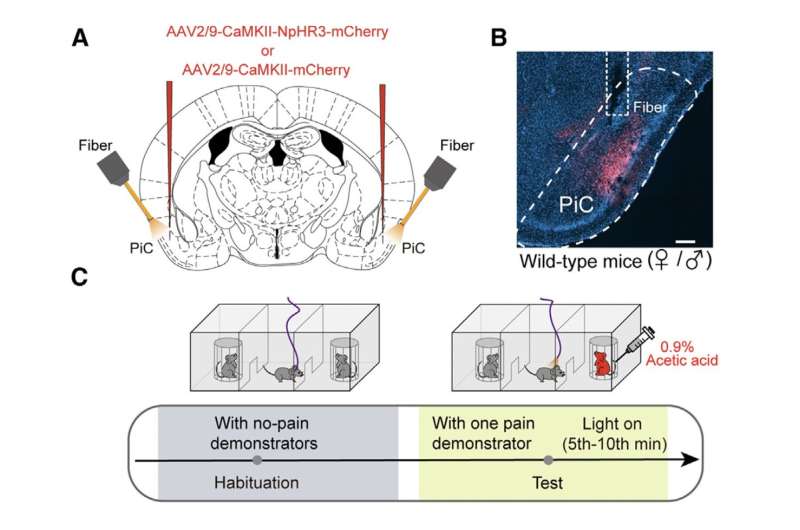May 21, 2024 feature
This article has been reviewed according to Science X's editorial process and policies. Editors have highlighted the following attributes while ensuring the content's credibility:
fact-checked
peer-reviewed publication
trusted source
proofread
Male and female mice exhibit different empathic behaviors to others' pain

Social interactions are multi-faceted experiences that entail understanding the emotional states of others and responding appropriately. Neuroscientists and psychologists have been studying social interactions for decades, in the hope of understanding their neural and behavioral underpinnings.
A team of researchers at Sun Yat-Sen University and University of Science and Technology of China recently carried out a study exploring how male and female mice respond to the pain of other mice. Their findings, published in Neuron, suggest that there are both neurobiological and behavioral differences between the two sexes, specifically in relation to their empathic responses.
"Recognizing the affective states of social counterparts and responding appropriately fosters successful social interactions," Sunchang Fang, Zhengyi Luo and their colleagues wrote in their paper. "However, little is known about how the affective states are expressed and perceived and how they influence social decisions."
The primary objective of the recent study by Fang, Luo and their collaborators was to delve deeper into how male and female mammals respond to another animal in pain, both in terms of their behavior and brain activity. To do this, they carried out a series of experiments on mice, where two mice were placed in lateral chambers, while an observing mouse was placed in the central section of a common cage.
One of the mice in the lateral chamber was given an injection that caused abdominal pain, while the other two were not administered anything. The researchers monitored the behavior of the mouse in the central part of the cage, who could explore the environment freely and thus whether to interact with the other mice and in what ways.
Initially, both male and female mice moved in their surroundings, displaying similar exploratory behaviors. Yet after a while, particularly towards the end of each experimental trial, the team found that male mice exhibited more grooming behaviors, while female mice demonstrated a social preference for the mouse that was in pain, as they spent more time in its proximity and sniffing it.
"We show that male and female mice emit distinct olfactory cues after experiencing distress," the researchers wrote. "These cues activate distinct neural circuits in the piriform cortex (PiC) and evoke sexually dimorphic empathic behaviors in observers.
"Specifically, the PiC → PrL pathway is activated in female observers, inducing a social preference for the distressed counterpart. Conversely, the PiC → MeA pathway is activated in male observers, evoking excessive self-grooming behaviors."
This distinct neural pathway that the researchers found to be activated in male observers originated from non-overlapping PiC neuron populations with different gene expression signatures. Notably, these gene expression signatures are regulated by transcription factors and sex hormones.
Overall, their observations suggest that male and female mice are biologically inclined to respond differently to other mice in pain. While females are more likely to get closer to a peer who is in pain, males tend to respond to another's pain with excessive self-grooming.
The results of this study could soon be explored further and validated in additional experiments. In the future, they could pave the way for the discovery of new neural processes underpinning sex-specific social behaviors.
"Our study unveils how internal states of social counterparts are processed through sexually dimorphic mechanisms at the molecular, cellular, and circuit levels and offers insights into the neural mechanisms underpinning sex differences in higher brain functions," the researchers wrote.
More information: Shunchang Fang et al, Sexually dimorphic control of affective state processing and empathic behaviors, Neuron (2024). DOI: 10.1016/j.neuron.2024.02.001
© 2024 Science X Network




















